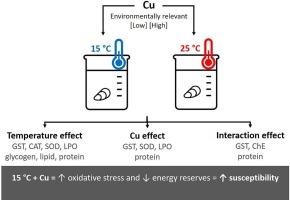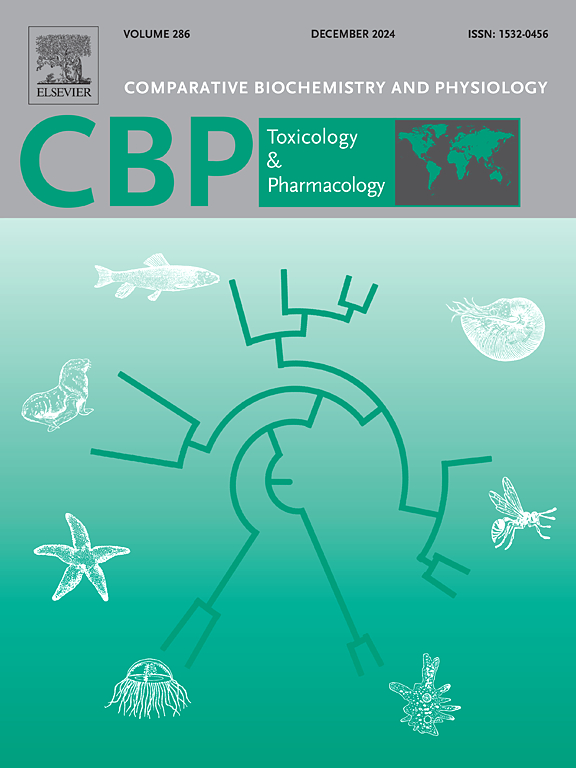温度是否会影响生物标志物对铜暴露的反应?以入侵双壳类动物 Limnoperna fortunei (Dunker 1857) 为模型。
IF 4.3
3区 环境科学与生态学
Q2 BIOCHEMISTRY & MOLECULAR BIOLOGY
Comparative Biochemistry and Physiology C-toxicology & Pharmacology
Pub Date : 2024-10-21
DOI:10.1016/j.cbpc.2024.110059
引用次数: 0
摘要
生物标志物是评估污染物预警效应的有用工具。然而,它们的反应可能会受到干扰因素的影响。在这项研究中,我们调查了温度对接触铜(Cu)的入侵淡水双壳贝类 Limnoperna fortunei 的多种生物标志物的影响。在两种温度(15 °C和25 °C)下,贻贝分别暴露于低浓度和高浓度的铜环境中。96 小时后,对氧化应激、神经毒性和代谢参数进行了评估。我们的结果表明,温度是影响贻贝生物标志物反应的关键因素,在低温条件下,谷胱甘肽 S-转移酶活性较高,能量储备较低。此外,在 15 °C 的最高浓度下,铜的影响更大(脂质过氧化和胆碱酯酶活性增加)。总之,这些研究结果表明,低温胁迫会增加 L. fortunei 对金属效应的敏感性,并强调了将温度纳入毒性测试和生物监测的重要性。此外,以入侵双壳类动物 L. fortunei 为模型,可以证明其作为其他生物的哨兵物种的价值。本文章由计算机程序翻译,如有差异,请以英文原文为准。

Does temperature influence on biomarker responses to copper exposure? The invasive bivalve Limnoperna fortunei (Dunker 1857) as a model
Biomarkers are useful tools for assessing the early warning effects of pollutants. However, their responses can be influenced by confounding factors. In this study, we investigated the influence of temperature on multiple biomarkers in the invasive freshwater bivalve Limnoperna fortunei exposed to copper (Cu). The mussels were exposed to low and high environmental Cu concentrations at two temperatures (15 °C and 25 °C). After 96 h, the oxidative stress, neurotoxicity, and metabolic parameters were assessed. Our results showed that temperature is a key factor influencing biomarker responses in mussels, with higher glutathione S-transferase activity and lower energy reserves at cold temperature. In addition, the effects of Cu were greater at the highest concentration at 15 °C (increased lipid peroxidation and cholinesterase activity). Overall, these findings suggest that cold stress increases the susceptibility of L. fortunei to metal effects and highlight the importance of including temperature in toxicity testing and biomonitoring. In addition, using the invasive bivalve L. fortunei as a model could prove valuable in its role as a sentinel species for other organisms.
求助全文
通过发布文献求助,成功后即可免费获取论文全文。
去求助
来源期刊
CiteScore
7.50
自引率
5.10%
发文量
206
审稿时长
30 days
期刊介绍:
Part C: Toxicology and Pharmacology. This journal is concerned with chemical and drug action at different levels of organization, biotransformation of xenobiotics, mechanisms of toxicity, including reactive oxygen species and carcinogenesis, endocrine disruptors, natural products chemistry, and signal transduction with a molecular approach to these fields.

 求助内容:
求助内容: 应助结果提醒方式:
应助结果提醒方式:


